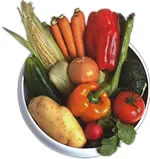Summertime is full of vigorous activities. One of the most rewarding activities is growing your own vegetables. Starting a vegetable garden takes careful planning and preparation, followed by hard labor, but the outcome makes it all worthwhile. Continue reading to learn how to start your own vegetable garden right at home!

The first step in creating your first vegetable garden is to plan the design, taking into consideration size and variety of produce. Newcomers to vegetable gardening would be wise to start small. You can always expand in future seasons after you know what you are able to handle.
Choosing vegetables that your family loves will make it a great treat to go shopping in your own garden to harvest fresh food. Some popular choices are beans, peas, tomatoes, corn, squash, cucumbers and peppers. Determine how much of each plant you will need to plant to meet your family’s needs and maybe plant a few extra if you want to share your crops.
Choosing a proper site on your lawn is of utmost importance. A spot near the house in full sunlight is the most convenient spot, however, drainage, soil quality and shade from buildings or trees may force you to locate your garden in an area farther from the house.
A good vegetable garden must have at least six hours of full sun each day in order for your crops to mature properly. The soil should be very fertile and well draining so that water will never puddle after an immense rainfall. While good air movement is important, windy areas should be avoided because they can dry out the soil or break plants. Choose a spot close to a water supply for convenience, and to avoid having to haul around a long hose.
It is helpful to draw a diagram of your prospective garden, mapping out each row according to height and plant requirements. Ideally the plants should grow from the smallest in the front to the tallest in back to maximize sun exposure and airflow.
Properly managed soil can make all the difference in how your vegetables will grow. An easy way to get soil with a balanced blend of nutrients is to buy a pre-mix to add to the soil at your site. These are formulated to produce the healthiest of plants. Prepare the soil by ridding it of any weeds, rocks and debris. Tilling and raking also are essential tasks to fluff and smooth the soil.
Now you’re ready to start planting. Using your garden layout you created in the planning stage, use stakes to mark where different rows will be planted. Create a grid-like pattern using string tied to the stakes to easily mark where each plant will go. Build trellises or set in tall stakes for climbing plants such as peas and beans. Create mounds to plant the vining crops such as cucumbers and melons. Don’t forget to establish your pathways early so you won’t walk across areas you just planted. Planting depths and spacing are critical, so don’t crowd your plants. Be sure to place a tag or marker on each row or area so that you will remember what plant will sprout there and when to expect it.
There are several different planting techniques to get your garden started. Random sowing is simply sprinkling the seeds over the soil and topping with enough soil to cover them. Water carefully, though, because too much moisture will flood the seeds out.
Furrow planting is done with using a hoe to create a straight furrow in the soil and then planting seeds every couple of inches. Then use the hoe to re-cover the furrow.
Another option is to use seed strips. You can buy tiny seeds of certain vegetables like radishes and carrots on paper strips. Stretch the strip out, lay it in a furrow then cover it up. The paper will decompose as the seeds sprout.
Transplants, starts and seedlings are started from seed indoors and then brought outside for planting once they’ve become sturdy plants.
Now it’s the time for watering, weeding, cultivating, mulching and watching for pests. Watering is essential especially in the early stages and throughout the season. Most vegetables benefit from an inch or more of water each week.
Weeds will rob your vegetables of water, light and root space so be sure to keep them pulled on a regular basis. Mulching between the rows will help to control weeds and conserve moisture in the soil.
Be vigilant about checking for pests. Early discovery of a problem will make it much easier to take appropriate action to eliminate the pests.
When you see the first sprout is when all of this hard work starts to seem worthwhile. And then when the plants are ready to harvest, you finally get to enjoy all of your labor.
But, be sure to note the expected harvest date and make it a point to get into the garden at the proper times to gather the ripe vegetables. Vegetables ripen fast during the heat of summer and can rot pretty quickly. If you’re going to be away for a week’s vacation, invite friends and neighbors to stop by and pick what ripens while you’re gone.
Starting a vegetable garden is time consuming, takes a lot of physical effort and is a true commitment. However, it is one of the most gratifying activities. The plants develop quickly and respond generously to good care. Only a short time after planting, you’ll be picking all you and your family can eat, with extras to share. So, get planning and enjoy!
Need more space?
Spruce up your garden with a handy and attractive
storage shed.
Plan 002D-4515, left, is available
at www.projectplans.com.
Here are some related articles:
Save this article to:
back to top